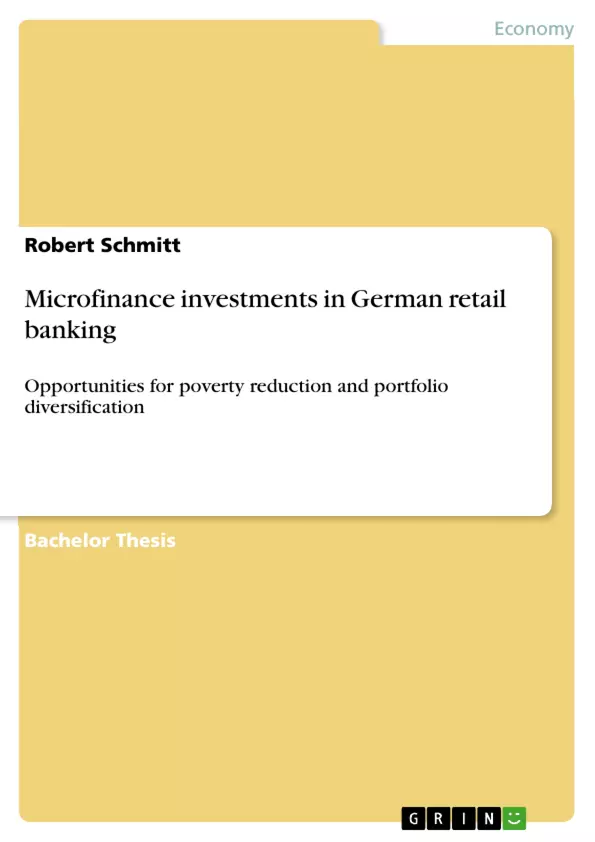Microfinance or the concept of providing small-sized loans to the unemployed poor through recent decades has transformed into an asset class that attracts commercially oriented investors from all over the world. While the majority of them still consist of institutional investors and high net worth individuals, large numbers of people who could potentially profit from a microfinance engagement lack access to appropriate investment products. Simultaneously, only a small fraction of the global funding demand of the microfinance industry is currently being met. This paper demonstrates that, for several reasons, German retail banking clients should be provided with opportunities to engage in this emerging asset class. It is shown that this client group not only can have a significant impact on poverty reduction by closing parts of the immense funding gap, but moreover it is able to gain advantages in terms of portfolio diversification from a microfinance engagement.
Inhaltsverzeichnis (Table of Contents)
- Abstract
- Table of Contents
- Table of Abbreviations
- Table of Figures
- 1 Introduction
- 2 The emergence of microfinance as an asset class
- 2.1 Historical developments
- 2.1.1 Micro-credit activities before 1900
- 2.1.2 The 20th century: The cradle of modern microfinance
- 2.2 Current state of the industry
- 2.1 Historical developments
- 3 Accessing commercial microfinance investment
- 3.1 Direct engagement
- 3.1.1 The domestic capital markets
- 3.1.2 Deposits and local equity
- 3.2 Indirect investment
- 3.2.1 Securitizations
- 3.2.2 Investment funds
- 3.2.2.1 Open-end funds
- 3.2.2.2 Closed-end funds
- 3.1 Direct engagement
- 4 Financial utility of microfinance investment
- 4.1 Microfinance investment in a portfolio context
- 4.2 The relationship of microfinance and the formal economy
- 4.2.1 Correlation of microfinance with the international economy
- 4.2.2 Correlation of microfinance with the German economy
- 5 Is microfinance investment for German retail banking clients?
- 5.1 Market segmentation
- 5.2 Legal environment
- 5.3 Financial regards
- 5.4 Social aspects
- 5.4.1 Social return on investment
- 5.4.2 The potential impact on poverty reduction
Zielsetzung und Themenschwerpunkte (Objectives and Key Themes)
This paper explores the potential of microfinance as an investment opportunity for German retail banking clients. The author aims to demonstrate that, despite the current limited access to such investments, there are compelling reasons to consider introducing them to this client group. The paper investigates the historical development and current state of the microfinance industry, examining various access points for commercial microfinance investment. It then analyzes the financial utility of microfinance investment, considering its role in portfolio diversification and its relationship with the formal economy. Finally, the paper evaluates the feasibility of microfinance investment for German retail banking clients, considering market segmentation, legal frameworks, financial considerations, and the potential social impact, particularly in terms of poverty reduction.- The emergence and current state of the microfinance industry as an asset class
- The financial utility of microfinance investment, including portfolio diversification and its relationship with the formal economy
- The feasibility of microfinance investment for German retail banking clients, considering market segmentation, legal frameworks, financial considerations, and the potential social impact
- The potential of microfinance to contribute to poverty reduction through increased access to capital
- The challenges and opportunities associated with introducing microfinance investments to German retail banking clients
Zusammenfassung der Kapitel (Chapter Summaries)
- Chapter 1 introduces the topic of microfinance investment and its potential significance for German retail banking clients. It highlights the growing interest in microfinance as an asset class and suggests that German retail banking clients could play a crucial role in bridging the funding gap and contributing to poverty reduction.
- Chapter 2 traces the historical development of microfinance, highlighting key milestones and individuals that shaped its evolution. It explores the emergence of microfinance as an asset class and examines the current state of the industry, including its global reach and the evolving needs of microfinance institutions.
- Chapter 3 delves into the various ways in which investors can access commercial microfinance investments, both directly through domestic capital markets and indirectly through securitizations and investment funds. It explores the different investment strategies available and the potential risks and rewards associated with each approach.
- Chapter 4 examines the financial utility of microfinance investment, discussing its role in portfolio diversification and its relationship with the formal economy. It explores the correlation of microfinance with both the international and German economies and the potential benefits of including microfinance assets in a diversified investment portfolio.
- Chapter 5 investigates the suitability of microfinance investment for German retail banking clients. It examines key factors such as market segmentation, legal frameworks, financial considerations, and the potential social impact of microfinance investment. The chapter discusses the challenges and opportunities associated with introducing microfinance investments to this client group and analyzes the potential for fostering financial inclusion and promoting social good.
Schlüsselwörter (Keywords)
Microfinance, investment, poverty reduction, portfolio diversification, retail banking, Germany, asset class, funding gap, social impact, social return on investment, financial inclusion, legal environment, market segmentation, financial utility.- Quote paper
- Robert Schmitt (Author), 2009, Microfinance investments in German retail banking, Munich, GRIN Verlag, https://www.grin.com/document/136028



